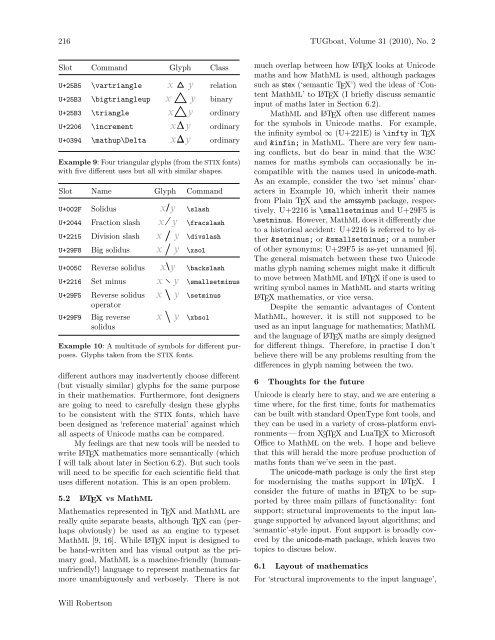Unicode mathematics in LATEX: Advantages and challenges - TUG
Unicode mathematics in LATEX: Advantages and challenges - TUG
Unicode mathematics in LATEX: Advantages and challenges - TUG
Create successful ePaper yourself
Turn your PDF publications into a flip-book with our unique Google optimized e-Paper software.
216 <strong>TUG</strong>boat, Volume 31 (2010), No. 2<br />
Slot Comm<strong>and</strong> Glyph Class<br />
U+25B5 \vartriangle x ▵ y relation<br />
U+25B3 \bigtriangleup x △ y b<strong>in</strong>ary<br />
U+25B3 \triangle x△y ord<strong>in</strong>ary<br />
U+2206 \<strong>in</strong>crement x∆y ord<strong>in</strong>ary<br />
U+0394 \mathup\Delta xΔy ord<strong>in</strong>ary<br />
Example 9: Four triangular glyphs (from the STIX fonts)<br />
with five different uses but all with similar shapes.<br />
Slot Name Glyph Comm<strong>and</strong><br />
U+002F Solidus x/y \slash<br />
U+2044 Fraction slash x ⁄ y \fracslash<br />
U+2215 Division slash x ∕ y \divslash<br />
U+29F8 Big solidus x ⧸ y \xsol<br />
U+005C Reverse solidus x\y \backslash<br />
U+2216 Set m<strong>in</strong>us x ∖ y \smallsetm<strong>in</strong>us<br />
U+29F5<br />
x ⧵ y \setm<strong>in</strong>us<br />
U+29F9<br />
Reverse solidus<br />
operator<br />
Big reverse<br />
solidus<br />
x ⧹ y \xbsol<br />
Example 10: A multitude of symbols for different purposes.<br />
Glyphs taken from the STIX fonts.<br />
different authors may <strong>in</strong>advertently choose different<br />
(but visually similar) glyphs for the same purpose<br />
<strong>in</strong> their <strong>mathematics</strong>. Furthermore, font designers<br />
are go<strong>in</strong>g to need to carefully design these glyphs<br />
to be consistent with the STIX fonts, which have<br />
been designed as ‘reference material’ aga<strong>in</strong>st which<br />
all aspects of <strong>Unicode</strong> maths can be compared.<br />
My feel<strong>in</strong>gs are that new tools will be needed to<br />
write L A TEX <strong>mathematics</strong> more semantically (which<br />
I will talk about later <strong>in</strong> Section 6.2). But such tools<br />
will need to be specific for each scientific field that<br />
uses different notation. This is an open problem.<br />
5.2 L A TEX vs MathML<br />
Mathematics represented <strong>in</strong> TEX <strong>and</strong> MathML are<br />
really quite separate beasts, although TEX can (perhaps<br />
obviously) be used as an eng<strong>in</strong>e to typeset<br />
MathML [9, 16]. While L A TEX <strong>in</strong>put is designed to<br />
be h<strong>and</strong>-written <strong>and</strong> has visual output as the primary<br />
goal, MathML is a mach<strong>in</strong>e-friendly (humanunfriendly!)<br />
language to represent <strong>mathematics</strong> far<br />
more unambiguously <strong>and</strong> verbosely. There is not<br />
much overlap between how L A TEX looks at <strong>Unicode</strong><br />
maths <strong>and</strong> how MathML is used, although packages<br />
such as stex (‘semantic TEX’) wed the ideas of ‘Content<br />
MathML’ to L A TEX (I briefly discuss semantic<br />
<strong>in</strong>put of maths later <strong>in</strong> Section 6.2).<br />
MathML <strong>and</strong> L A TEX often use different names<br />
for the symbols <strong>in</strong> <strong>Unicode</strong> maths. For example,<br />
the <strong>in</strong>f<strong>in</strong>ity symbol ∞ (U+221E) is \<strong>in</strong>fty <strong>in</strong> TEX<br />
<strong>and</strong> &<strong>in</strong>f<strong>in</strong>; <strong>in</strong> MathML. There are very few nam<strong>in</strong>g<br />
conflicts, but do bear <strong>in</strong> m<strong>in</strong>d that the W3C<br />
names for maths symbols can occasionally be <strong>in</strong>compatible<br />
with the names used <strong>in</strong> unicode-math.<br />
As an example, consider the two ‘set m<strong>in</strong>us’ characters<br />
<strong>in</strong> Example 10, which <strong>in</strong>herit their names<br />
from Pla<strong>in</strong> TEX <strong>and</strong> the amssymb package, respectively.<br />
U+2216 is \smallsetm<strong>in</strong>us <strong>and</strong> U+29F5 is<br />
\setm<strong>in</strong>us. However, MathML does it differently due<br />
to a historical accident: U+2216 is referred to by either<br />
&setm<strong>in</strong>us; or &smallsetm<strong>in</strong>us; or a number<br />
of other synonyms; U+29F5 is as-yet unnamed [6].<br />
The general mismatch between these two <strong>Unicode</strong><br />
maths glyph nam<strong>in</strong>g schemes might make it difficult<br />
to move between MathML <strong>and</strong> L A TEX if one is used to<br />
writ<strong>in</strong>g symbol names <strong>in</strong> MathML <strong>and</strong> starts writ<strong>in</strong>g<br />
L A TEX <strong>mathematics</strong>, or vice versa.<br />
Despite the semantic advantages of Content<br />
MathML, however, it is still not supposed to be<br />
used as an <strong>in</strong>put language for <strong>mathematics</strong>; MathML<br />
<strong>and</strong> the language of L A TEX maths are simply designed<br />
for different th<strong>in</strong>gs. Therefore, <strong>in</strong> practise I don’t<br />
believe there will be any problems result<strong>in</strong>g from the<br />
differences <strong>in</strong> glyph nam<strong>in</strong>g between the two.<br />
6 Thoughts for the future<br />
<strong>Unicode</strong> is clearly here to stay, <strong>and</strong> we are enter<strong>in</strong>g a<br />
time where, for the first time, fonts for <strong>mathematics</strong><br />
can be built with st<strong>and</strong>ard OpenType font tools, <strong>and</strong><br />
they can be used <strong>in</strong> a variety of cross-platform environments<br />
— from X TEX <strong>and</strong> LuaTEX to Microsoft<br />
Office to MathML on the web. I hope <strong>and</strong> believe<br />
that this will herald the more profuse production of<br />
maths fonts than we’ve seen <strong>in</strong> the past.<br />
The unicode-math package is only the first step<br />
for modernis<strong>in</strong>g the maths support <strong>in</strong> L A TEX. I<br />
consider the future of maths <strong>in</strong> L A TEX to be supported<br />
by three ma<strong>in</strong> pillars of functionality: font<br />
support; structural improvements to the <strong>in</strong>put language<br />
supported by advanced layout algorithms; <strong>and</strong><br />
‘semantic’-style <strong>in</strong>put. Font support is broadly covered<br />
by the unicode-math package, which leaves two<br />
topics to discuss below.<br />
6.1 Layout of <strong>mathematics</strong><br />
E<br />
For ‘structural improvements to the <strong>in</strong>put language’,<br />
Will Robertson

















